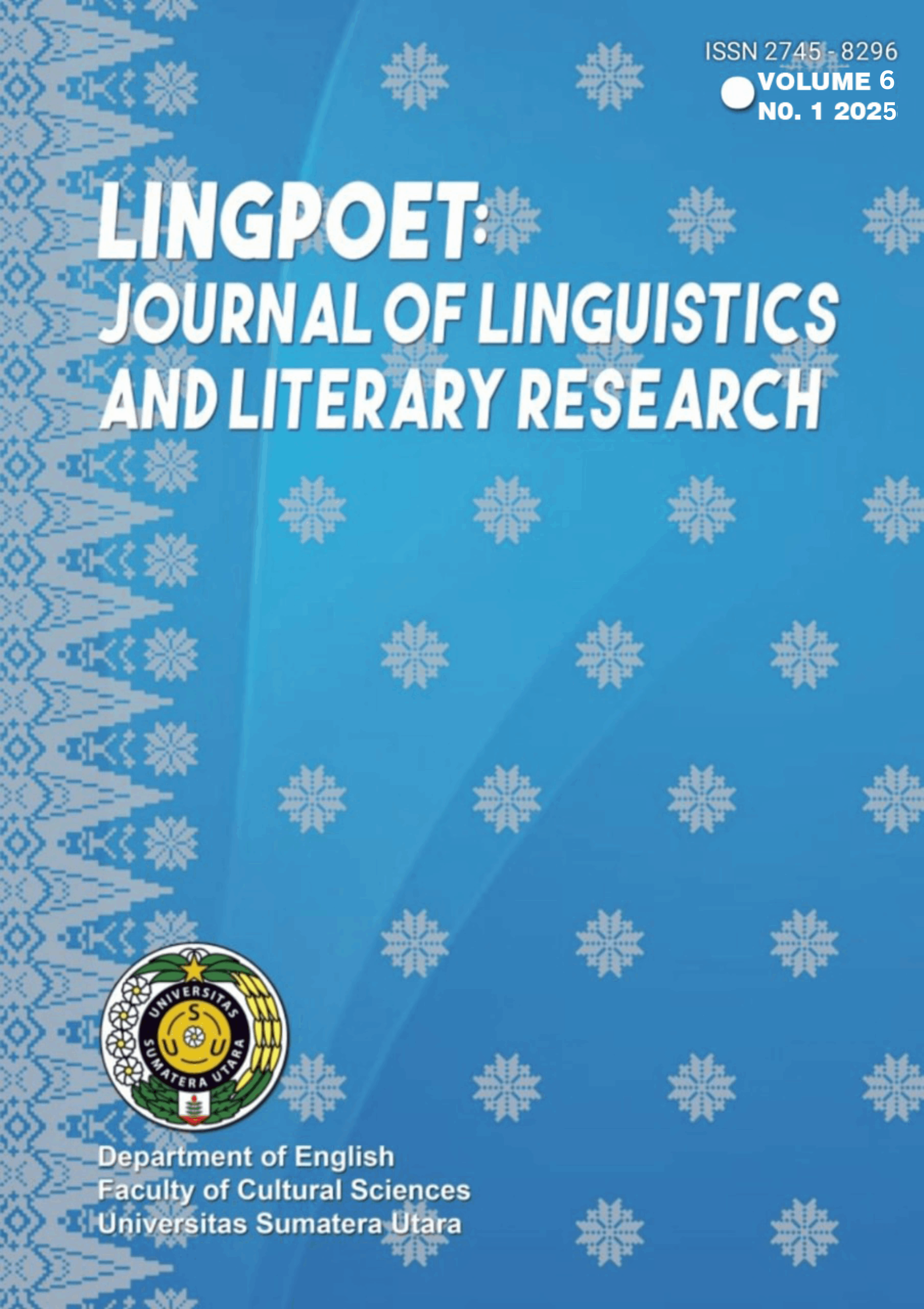Temporal Metaphors as a Linguistic Phenomenon: Conceptual Frameworks across Different Languages
DOI:
https://doi.org/10.32734/lingpoet.v6i1.19866Keywords:
Language and Cognition, Linguistic Relativity, Temporal MetaphorsAbstract
Metaphors are not merely decorative linguistic devices but play a significant role in shaping cognition and cultural understanding. The influence of linguistic background on thought processes is central to the Sapir-Whorf Hypothesis, which posits that language shapes cognitive perception and cultural behaviour. This study aims to explore the relationship between language and cognition through the lens of temporal metaphors. By examining linguistic frameworks across diverse cultures, the research seeks to demonstrate how temporal metaphors influence cognitive processes, cultural practices, and perceptions of time. A qualitative approach was employed, synthesising theoretical and empirical literature on metaphor, linguistic relativity, and temporal cognition. The analysis focused on case studies from languages such as English, Mandarin, Hopi, and Aymara, highlighting both universal and culturally specific temporal metaphors. The study reveals that temporal metaphors vary significantly across languages, reflecting unique cultural perspectives while exhibiting shared cognitive patterns. For instance, English and Mandarin conceptualise time through horizontal and vertical orientations, respectively, while Hopi and Aymara temporal frameworks challenge conventional Western notions. The findings support the weaker form of the Sapir-Whorf Hypothesis, showing that language influences thought without rigidly determining it. Furthermore, the research demonstrates that temporal metaphors are essential cognitive tools, shaping abstract concepts and influencing behaviour across cultural contexts.
Downloads
References
Aristotle (c. 335 B.C./1996). Poetics. (M. Davis, Trans.). The Peripatetic Press.
Athanasopoulos, P., Bylund, E., Montero-Melis, G., Damjanovic, L. et al. (2015). Two languages, two minds: Flexible cognitive processing driven by language of operation. Psychological Science, 26(4), 518–526.
Aziz-Zadeh, L., Wilson, S. M., Rizzolatti, G., & Iacoboni, M. (2006). Congruent embodied representations for visually presented actions and linguistic phrases describing actions. Current Biology, 16(18), 1818–1823.
Barsalou, L. W. (2008). Grounded cognition. Annual Review of Psychology, 59, 617–645.
Boroditsky, L. (2001). Does language shape thought? Mandarin and English speakers’ conceptions of time. Cognitive Psychology, 43(1), 1–22.
Boroditsky, L., Schmidt, L. A., & Phillips, W. (2003). Sex, syntax and semantics. In Gentner D. & Goldin-Meadow S. (Eds.), Language in mind: Advances in the study of language and thought. MIT Press, 61–79.
Boroditsky, L. (2011). How language shapes thought. Scientific American, 304(2), 62–65.
Buckley, G. (n.d.). Intraspeaker relativity. University of Pennsylvania Department of Linguistics. https://www.ling.upenn.edu/~gene/courses/2041/08b-t.html (Accessed: 5 December 2024).
Casasanto, D. (2008). Similarity and Proximity: When does close in space mean close in mind? Memory & Cognition, 36(6), 1047–1056.
Cassirer, E. (2020). The philosophy of symbolic forms: Volume 1. Language (S. G. Lofts, Trans.; P. E. Gordon, Foreword). Routledge.
Cicero, M. T. (1942). De Oratore, Book III. (H. Rackham, Trans.). Harvard University Press.
Citron, F. M., & Goldberg, A. E. (2014). Metaphorical sentences are more emotionally engaging than their literal counterparts. Journal of Cognitive Neuroscience, 26(11), 2585–2595.
Cooperrider, K., & Núñez, R. (2016). How we make sense of time. Scientific American. https://www.scientificamerican.com/article/how-we-make-sense-of-time/ (Accessed: 27 December 2024).
Degroot, V. M. Y. (2009). Candi, space and landscape: A study on the distribution, orientation and spatial organization of Central Javanese temple remains (Doctoral dissertation, Leiden University). Leiden University Repository. https://scholarlypublications.universiteitleiden.nl/handle/1887/13781 (Accessed: 18 November 2024).
Evans, N., & Levinson, S. C. (2009). The myth of language universals: Language diversity and its importance for cognitive science. Behavioral and Brain Sciences, 32, 429–492.
Fauconnier, G., & Turner, M. (2002). The way we think: Conceptual blending and the mind’s hidden complexities. Basic Books.
French, E., & Hanes, R. C. (n.d.). Hopis. Everyculture.com. https://www.everyculture.com/multi/Ha-La/Hopis.html (Accessed: 5 December 2024).
Fuhrman, O., McCormick, K., Chen, E., Jiang, H., Shu, D., Mao, S., & Boroditsky, L. (2011). How linguistic and cultural forces shape conceptions of time: English and Mandarin time in 3D. Cognitive Science, 35(7), 1305–1328.
Gentner, D. (1983). Structure-mapping: A theoretical framework for analogy. Cognitive Science, 7(2), 155–170.
Gentner, D., Imai, M., & Boroditsky, L. (2002). As time goes by: Evidence for two systems in processing space time metaphors. Language and Cognitive Processes, 17(5), 537–565.
Harbeck, J. (2018, August 6). Can language slow down time? BBC Culture. https://www.bbc.com/culture/article/20180806-can-language-slow-down-time (Accessed: 5 December 2024).
Herder, J. G. (2002). Treatise on the Origin of Language. In M. N. Forster (Ed. & Trans.), Herder: Philosophical Writings (pp. 65–164). Cambridge University Press.
Humboldt, W. von. (1999). On Language: On the Diversity of Human Language Construction and Its Influence on the Mental Development of the Human Species (P. Heath, Trans.; M. Losonsky, Ed.). Cambridge University Press.
Huszka, B. & Stark, A. (2013): Zur (Un-)Übersetzbarkeit religiöser Texte. Allemania, 3(1), 1–9.
Justo. (2024, March 28). Overview of the Hopi language and its unique features. NativeTribe.info. https://nativetribe.info/overview-of-the-hopi-language-and-its-unique-features/ (Accessed: December 5, 2024).
Kircher, T., Leube, D., Erb, M., Grodd, W., & Rapp, A. (2007). Neural correlates of metaphor processing in schizophrenia. Neuroimage, 34(1), 281–289.
Kövecses, Z. (2005). Metaphor in culture: Universality and variation. Cambridge University Press.
Kranjec, A., & Chatterjee, A. (2010). Are temporal concepts embodied? A challenge for cognitive neuroscience. Frontiers in Psychology. https://www.frontiersin.org/journals/psychology/articles/10.3389/fpsyg.2010.00240/full (Accessed: 27 December 2024).
Lacey, S., Stilla, R., & Sathian, K. (2012). Metaphorically feeling: Comprehending textural metaphors activates somatosensory cortex. Brain and Language, 120(3), 416–421.
Lakoff, G., & Johnson, M. (1980). Metaphors we live by. University of Chicago Press.
Lakoff, G. (1990). The Invariance Hypothesis: is Abstract Reason Based on Image-Schemas? Cognitive Linguistics, 1(1), 39–74.
Lakoff, G., & Johnson, M. (1999). Philosophy in the flesh: The embodied mind and its challenge to Western thought. Basic Books.
Levinson, S. C. (2003). Space in language and cognition: Explorations in cognitive diversity. Cambridge University Press.
Lucy, J. A. (1992). Grammatical categories and cognition: A case study of the linguistic relativity hypothesis. Cambridge University Press.
Magnis-Suseno, F. (1997). Javanese ethics and world-view: The Javanese idea of the good life. PT Gramedia Pustaka Utama.
Mallaeva, Z. M., Khalidova, R. S., Kadachieva, K. M., Alieva, P. G., & Shamsudinova, S. E. (2020). Time structuring in languages of different typologies. The European Proceedings of Social and Behavioural Sciences. https://www.europeanproceedings.com/article/10.15405/epsbs.2020.10.05.280 (Accessed: 27 December 2024).
Malotki, E. (1983). Hopi time: A linguistic analysis of the temporal concepts in the Hopi language. Mouton Publishers.
Matsuki, K. (1995). Metaphors of anger in Japanese. In J. R. Taylor & R. E. MacLaury (Eds.), Language and the Cognitive Construal of the World (pp. 137–152). Mouton de Gruyter.
McCluskey, S. C. (1985). Language, time, and astronomy among the Hopi. Archaeoastronomy: The Journal of the Center for Archaeoastronomy, 8, 152–155.
Meichenbaum, D. (1995). A clinical handbook/practical therapist manual for assessing and treating adults with post-traumatic stress disorder (PTSD). Institute Press.
Pinker, S. (1994). The language instinct. William Morrow and Company.
PsychologyFor. (n.d.). Aymaras: Who they are, history and characteristics of this culture. PsychologyFor. https://psychologyfor.com/aymaras-who-they-are-history-and-characteristics-of-this-culture/ (Accessed: 27 December 2024).
Rogus. (n.d.). A unique perspective on time: The fascinating language of Aymara. Medium. https://medium.com/@rogusblogus/a-unique-perspective-on-time-the-fascinating-language-of-aymara-a8b5eb7c074a (Accessed: 27 December 2024).
Quintilian (2001). Institutio Oratoria. (D. A. Russell, Trans.). Harvard University Press.
Sapir, E. (1929). The status of linguistics as a science. Language, 5(4), 207–214.
Simply Psychology. (n.d.). Sapir-Whorf hypothesis (linguistic relativity hypothesis). Simply Psychology. https://www.simplypsychology.org/sapir-whorf-hypothesis.html (Accessed: 5 December 2024).
Sinha, C., & Bernárdez, E. (2015). Space, time, and space–time: Metaphors, maps, and fusions. In F. Sharifian (Ed.), The Routledge handbook of language and culture (pp. 309–324). Routledge.
Su, Y. (2019). Comparison of Temporal Conception between Chinese and English. Studies in Asian Social Science, 6(1), 11.
Swan, M., & Smith, B. (2001). Learner English: A teacher's guide to interference and other problems. Cambridge University Press.
Whorf, B. L. (1956). Language, thought, and reality: Selected writings of Benjamin Lee Whorf. MIT press.
Winawer, J., Witthoft, N., Frank, M. C., Wu, L. et al. (2007). Russian blues reveal effects of language on color discrimination. Psychological and Cognitive Sciences 104(19), 7780–7785.
Yang, W., Gu, Y., Fang, Y., & Sun, Y. (2022). Mental Representations of time in English monolinguals, Mandarin monolinguals, and Mandarin–English bilinguals. Frontiers in Psychology, 13.
Yu, N. (1998). The contemporary theory of metaphor: A perspective from Chinese. Human Cognitive Processing, 1, 11–63.
Downloads
Published
How to Cite
Issue
Section
License
Copyright (c) 2025 LingPoet: Journal of Linguistics and Literary Research

This work is licensed under a Creative Commons Attribution-ShareAlike 4.0 International License.













